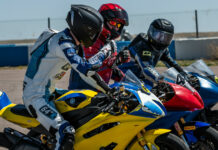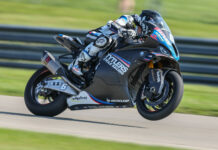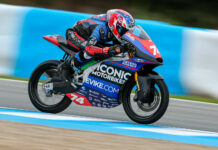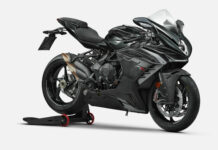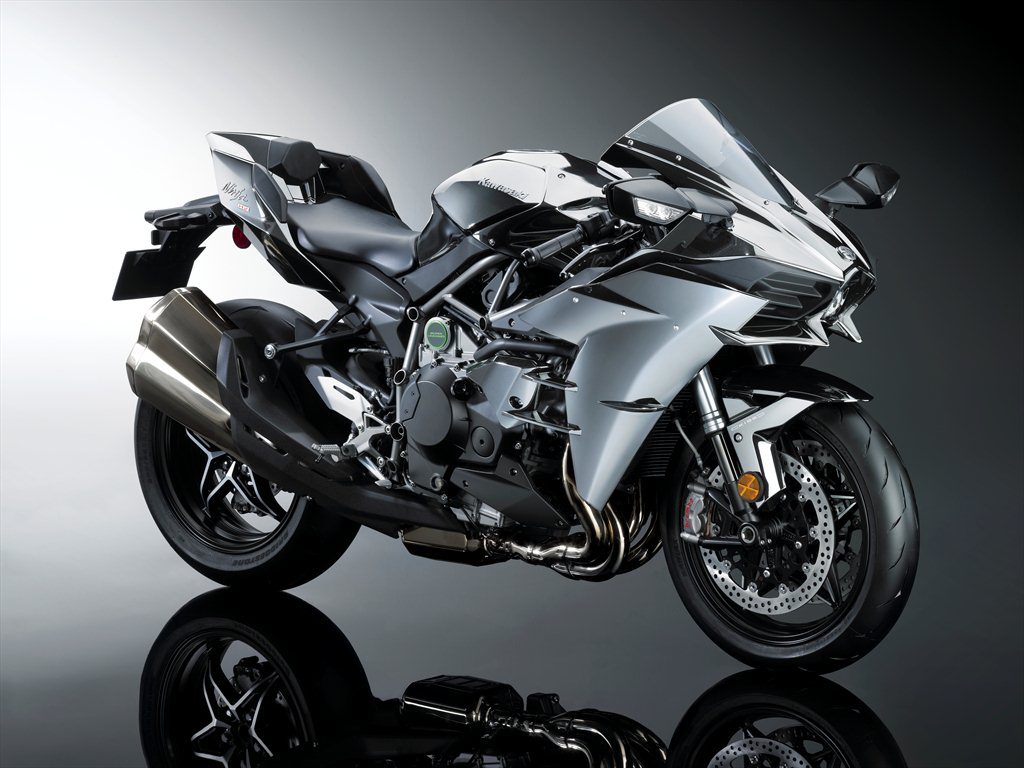2016 KAWASAKI NINJA H2™ & NINJA H2™R
Still Built Beyond Belief
It is beyond doubt that the Kawasaki Ninja H2 and its track-only counterpart, the Ninja H2R, were the sensation of the last 12 months. Not only did they recently receive awards from two leading US publications, but they werehighly praised by everybody fortunate enough to ride one. Several examples have already taken their place in museums, such as the Motorcycle Museum at Barber Motorsports Park, and more will surely follow. And perhaps the greatest accolade of all was the people’s choice –it seemed as if almost every video featuring these twoextraordinary supercharged Kawasaki superbikes would register more than one million views in a short space of time.
These spectacular motorcycles share many components, including the 998cc inline four-cylinder engine, proprietary supercharger, trellis frame, compact superbike dimensions, aerodynamic bodywork, single-sidedswingarm, powerful Brembo® brakes and so much more. For the 2016 model year, Kawasaki Motors Corp., U.S.A. will be offering another order period for customers who are anxious to get hold of these special machines. And for 2016, the road-legal Ninja H2 will receive a new Assist and Slipper clutch. This will make lever pressure 40% lighter, reducing rider fatigue on longer journeys, as well as helping to avoid rear-wheel hop when executing aggressive downshifts. Both motorcycles are now available in Mirror Coated Spark Black which is a revised silver-mirror paint that includes glass flakes in the first clear coat to catch the light, giving a high-quality metallic style appearance.
With the addition of the new Ninja H2 clutch components, the two supercharged sportbikes remain the mostexciting motorcycles available, and their limited availability ensures exclusivity for their owners.
HIGHLIGHTS OF THE 2016 KAWSAKI NINJA H2R & NINJA H2:
-998cc four-cylinder engine fitted with Kawasaki supercharger for intense acceleration
-Supercharger uses planetary gears, spins at up to 130,000rpm and develops up to 20.5psi boost pressure
-MotoGP™-style dog-ring transmission allows fast shifting and works with standard quick shifter
-Bodywork developed with Kawasaki Aerospace Company to generate downforce
-Kawasaki River Mark used to indicate combined Kawasaki Group technology
-Trellis frame used for first time on a Kawasaki motorcycle to provide strength, controlled flex and air circulation
-Single-sided swingarm used for first time by Kawasaki and mounted to the engine
-KYB® AOS-II Air-Oil Separate cartridge fork, adjustable KYB rear shock
-330mm front discs with four-piston Brembomonobloccalipers
-Multi-mode traction control, launch control, engine braking control, ABS and a quick shifter
-NEW Assist & Slipper clutch function gives lighter clutch operation and overcomes wheel hop on downshifts
-Ninja H2 is fully street-legal, Ninja H2R is designed for closed-circuit use only
Ninja H2 development pursued two paths. The first was the Ninja H2R, which is a closed-course model that allowed Kawasaki engineers to pursue unadulterated performance without the limitations of street or racinghomologation. This motorcycle was followed by the Ninja H2 street model, which is based closely on the H2Rand meets all market regulations. The results are incredible, with both models offering a sensory experience surpassing anything else that riders can find today.
NINJA H2 ENGINE & TRANSMISSION
The supercharged engine in the Ninja H2 is based closely on the powerplantin the Ninja H2R. The 998cc inline four-cylinder configuration is similar to modern superbike engines, allowing the engineers to build a nimble chassis for these powerhouses.
A great deal of work was done to ensure the motorscould cope with the supercharger application. The combustion chamber design, for example, is complemented by durable flat piston crowns. The shape wasinspired by the pistons used in the Green® Gas Engine developed by Kawasaki’s Gas Turbine & Machinery Company, contributing to the engine’s anti-knock performance. The intake valves are stainless steel, while the exhaust valves are formed from two materials – Inconel and heat-resistant steel – that are friction-welded at thecenter. This design is able to withstand the high exhaust temperatures produced under hard acceleration.
The supercharger was designed in-house by several companies within Kawasaki Heavy Industries, Ltd.,thusallowingthe opportunity to perfectly match the engine characteristics of the Ninja H2 and H2R.The supercharger’s high efficiency and minimal heat gain meant an intercooler was unnecessary, allowing savings in both weight and space.The supercharger is located centrally, behind the cylinder bank, in the best position toevenly distributethe compressed air to all four cylinders.
The supercharger is driven by a planetary geartrain, which runs off the crankshaft.The geartrain increases the impeller speed up to 9.2x the crank speed (1.15x step gear with an 8x planetary gear).This means at amaximum engine speed of approximately 14,000rpm, the impeller shaft is spinning at almost 130,000rpm.
To facilitate smooth, quick shifting, a dog-ring-type transmission was selected.This is similar to the kind commonly found in MotoGP™and was developed with the Kawasaki Racing Team (KRT).The dog-rings are lighter than conventional transmission gears, this type of transmission offerssignificantly lighter shift effort,facilitating quicker acceleration.
New for 2016, a high-quality clutch with Assist and Slipper function has been added to the Ninja H2transmission. This results in a 40% lighter clutch pull and stronger clamping force during clutch engagement.The previous Brembo parts are used for both the clutch lever’s radial-pump master cylinder and clutch release mechanism, giving superb linearity and smooth actuation. Additionally, the back-torque limiting Slipper function of the clutch contributes to stability by helping to prevent wheel hop during aggressive downshifts.
CHASSIS
Specifying a trellis frame for the Ninja H2 and Ninja H2R motorcycles offered an elegant, lightweight solution to meet the performance requirements of the street version H2 and closed-course Ninja H2R.Able to harness the power of the engine, it has a balance of stiffness and flexibility that enables a high level of stability while being able to handle external disturbances at high speed.Its open design also helps to dissipate heat generated by the supercharged engine.
The Ninja H2 and H2R feature the first Kawasakiproduction single-sided swingarm. Having a single-sidedswingarm allows the exhaust pipe to be mounted closer to the bike’scenterline, providing a high bank angle for sporty cornering.
SUSPENSION
The KYB AOS-II 43mm front fork on these innovative motorcycles is designed for low friction, with a smooth initial action followed by strong damping at the end of the stroke.
Fully adjustable KYB rear suspension offers superb stability. The top of the rear shock mounts to theswingarm mounting plate, doing away with the need for frame crossmembers.
The bottom of the rear shock is mounted via aUni-Trak® linkage that offers excellent feedback forrear tire grip.The linkage, situated below the swingarm, also mounts to the swingarm mounting plate.
BRAKES
Given the high-speed potential of the Ninja H2 and H2R, the brakes chosen were the best available for aproduction motorcycle.A front Brembo radial-pump master cylinder and reservoir receive extra attention before being shipped to Kawasaki. Each part is examined and adjusted to help eliminate any play in the lever stroke, sothat the brakes respond immediately when they are applied.
A pair of massive 330mm Brembo semi-floating front discs, with a thickness of 5.5mm, deliverexcellentbraking force.Dual radial-mount Brembo cast monobloccalipers grip the front discs.The rigid, opposed four-piston calipers with 30mm pistonscontribute to the braking power of the Ninja H2 and H2R.
A large 250mm disc generates strong braking force at the rear as well.
KTRC (KAWASAKI TRACTION CONTROL)
The KTRC system used on the Ninja H2 and H2R combines the best elements of earlier Kawasaki TRactionControl Systems.Multi-level modes offer riders a greater number of settings to choose from, with each mode providing a different level of intrusion to suit riding conditions and rider preference. And all modes are designed to manage output when sudden wheel slip occurs.The system offers both enhanced sport riding performance and the peace of mind to negotiate slippery surfaces with confidence.Riders can choose from three modes, each offering a progressively greater level of intrusion.Each of these modesalso has three rider-selectable levels, adding more or less intrusion (rider preferences for each mode are programmable for on-the-move selection), giving a total of nine possible settings.Riders may also elect to turn the system off. Mode 1 and 2 are tailored for circuit riding, while Mode 3 was optimized formore slippery conditions.
KLCM (KAWASAKI LAUNCH CONTROL MODE)
Designed to assist the rider by optimizing acceleration from a stop, KLCM KawasakiLaunch Control Modeelectronically controls engine output to prevent wheelspin and control wheel lift when launching.Riders can choose from three modes, each offering a progressively greater level of intrusion.Each mode allows the rider to launch from a stop with the throttle held wide open.
KIBS (KAWASAKI INTELLIGENT ANTI-LOCK BRAKE SYSTEM)
Kawasaki’s supersport-style ABS is standard equipment on the Ninja H2 and H2R.This is based on the same system used on the Ninja ZX-10R, with programming and settings revised to suit the performance parameters of the Ninja H2 and H2R.High-precision brake pressure control enables the system to avoid reduced brake performance due to excessive pressure drops, allows lever feel to be maintained when KIBS is active, and helps ensure ABS pulses feel smooth (not heavy).
KQS (KAWASAKI QUICK SHIFTER)
Ninja H2 and H2R were the first Kawasaki motorcycles to be fitted with a standard quick shifter. Complementing the engine’s strong power and the dog-ring transmission, a contactless-type quick shifter enables rapid upshifts for seamless acceleration.
ÖHLINS®ELECTRONIC STEERING DAMPER
Unlike a mechanical steering damper – in which the settings, once fixed, must cover all riding conditions and speeds – the damping characteristics are changed electronically, according to vehicle speed and the degree of acceleration or deceleration.
At low speeds, the settings were chosen so that damping does not interfere with the bike’s intrinsic lightweight handling.At high speeds, damping increases to provide enhanced stability.Kawasaki’s electronic steering damper was developed with Öhlins®, one of the most popular and respected steering dampermanufacturers.The electronic steering damper provides just the right amount of damping based on what the bike is doing.Using input from the rear wheel speed sensor (provided via the engine ECU), the electronic steering damper’s ECU determines the vehicle speed as well as the degree the bike is accelerating or decelerating.
STYLING & CRAFTSMANSHIP
Wanting to ensure a bold design worthy of a model that carries both the “Ninja” and “H2” names, the prime styling concept for the Ninja H2R was “Intense Force” design.
As a flagship for the Kawasaki brand, it needs to have presence, and styling that reflects its incredible performance.But the design is much more than cosmetic.While its edged styling certainly looks the part, the Ninja H2 and H2R also possesses a functional beauty: each piece of the bodywork was aerodynamically sculpted to enhance high-speed stability; the cowling design also maximizes cooling performance and heat dissipation, aiding the engine’s incredible output; and the ram air duct is ideally positioned to bring air to the supercharger.
More than any Kawasaki motorcycle to date, the Ninja H2 and H2Rshowcase craftsmanship, build quality and superb fit and finish – right down to the revised, high-tech silver-mirrorpaint specially developed for thesemodels.
BODYWORK
It is no accident that when viewed from the side, the Ninja H2 and H2R motorcycles do not have the aggressive forward-canted rake of most modern supersport motorcycles. While supersport bikes use their front-leaning attitude to aid quick steering, at the speeds for which the closed-course Ninja H2R motorcycle was designed, such a posture would create drag, which would hinder top speed potential.
The Ninja H2R front cowl is formed from lightweight carbon fiber and is designed to afford wind protection at ultra-high speed, with its tall screen designed to help create a wind-free pocket for the rider. Compact side cowls and under cowls were designed to assist with engine heat dissipation. The rear cowl has an extremely compact three-piece design. The center portion is taller, creating an aerodynamic form that helps smooth airflow as it passes the rider. Wind is also able to pass between the center and side pieces, further reducing air resistance.
The Ninja H2 motorcycle uses similar bodywork, although it is not made from carbon fiber. Mindful of its street use, it is equipped with a front headlight, mirrors and turn signals to make it fully road legal. It is also finished in arevised silver-mirror paint giving a high-quality metallic-style appearance.
GENERATING DOWNFORCE
The Ninja H2Rmotorcycle features a number of aerodynamic devices to help ensure the front wheel has strong contact with the ground and to contribute towards the motorcycle’s high-speed stability.The design of the upper cowl incorporates a chin spoiler. Rather than being a cosmetic flourish, it produces downforce that contributes to high-speed stability. Further contributing to high-speed stability, the Ninja H2Rmotorcycle features carbon fiberwings mounted on the upper cowl in place of the mirrors. Additional two-blade wings appear on the side cowlsfeaturing winglets and further add to the downforce generated by the chin spoiler and upper wings.
INSTRUMENTATION & CONTROLS
The advanced, high-tech design of the instrumentation conveys the image of piloting a fighter jet.Handlebarcontrol switches put all mode selection and display options at the rider’s fingertips. The new instrumentation design combines a full digital LCD screen with an analog-style tachometer. The LCD screen uses a black / white reverse display (white characters on a black background), contributing to the high-quality image. In addition to the digital speedometer and gear position indicator, display functions include: odometer, dual trip meters, current mileage, average mileage, fuel consumption, coolant temperature, boost indicator, boost (intake air chamber) temperature, stopwatch (lap timer), clock and the Economical Riding Indicator.
LIGHTING EQUIPMENT
Ninja H2 is equipped with all the lights needed for street-legal operation. And with the exception of the bulb illuminating the license plate, all lighting equipment on the Ninja H2 uses LEDs.The Ninja H2R has no headlight or indicator but does have a rear brake light.
HIGH-PRECISION PRODUCTION
Unlike a regular mass-production model, the high-precision production of the Ninja H2 and H2R requires greater hands-on participation by skilled Kawasaki craftsmen.So each step, from metalworking, treatment, welding andpainting to assembly, fine-tuning and inspection is carefully attended to create a product of superior quality.Within the Kawasaki Akashi Factory in Japan, production takes place in an area dedicated exclusively to the Ninja H2R motorcycle.
ORDERING INFORMATION
The 2016 Kawasaki Ninja H2R and H2 are limited release, production motorcycles. Reservations for the 2016 Ninja H2R will be taken on a first-come, first-served basis through Kawasaki’s Customer Order Program by placing a deposit with an authorized dealer. The customer order period for the H2R is open from November 16 through December 11, 2015. A very limited number of 2016 Ninja H2 units will be available in the U.S. market through dealers. Please contact your dealer for availability.
ABOUT KAWASAKI
Kawasaki Heavy Industries, Ltd. (KHI) started full-scale production of motorcycles over a half century ago. The first Kawasaki motorcycle engine was designed based on technical know-how garnered from the development and production of aircraft engines, and Kawasaki’s entry into the motorcycle industry was driven by the company’s constant effort to develop new technologies. Numerous new Kawasaki models introduced over the years have helped shape the market, and in the process have created enduring legends based on their unique engineering, power, design and riding pleasure. In the future, Kawasaki’s commitment to maintaining and furthering these strengths will surely give birth to new legends.
Kawasaki Motors Corp., U.S.A. (KMC) markets and distributes Kawasaki motorcycles, ATVs, side x sides, and Jet Ski® watercraft through a network of almost 1,200 independent retailers, with close to an additional 7,400 retailers specializing in general purpose engines. KMC and its affiliates employ nearly 3,100 people in the United States, with approximately 300 of them located at KMC’s Irvine, California headquarters.
Kawasaki’s tagline, “Let the good times roll.™”, is recognized worldwide. The Kawasaki brand is synonymous with powerful, stylish and category-leading vehicles. Information about Kawasaki’s complete line of powersports products and Kawasaki affiliates can be found on the Internet at www.kawasaki.com.


